Liposomal dual delivery systems in visceral leishmaniasis enhance the synergistic effects of combination therapy: A promise for the future
Raghunath Hazra,Amrita Kar,Santanu Kar Mahapatra
Department of Paramedical and Allied Health Sciences, Biodiversity and Environmental Studies Research Centre, Midnapore City College, Kuturiya,Bhadutala, Paschim Medinipur- 721129, West Bengal, India
ABSTRACT Visceral leishmaniasis (VL) is a neglected tropical disease,and this review has summarized the current treatment scenario and its prospects.It also highlights alternative approaches used by research groups in India and around the world to develop cuttingedge and potent anti-leishmanial treatments.Even though numerous medications could be utilized to treat VL,the limitations of current treatments including their toxicity,cost,route of administration,and duration of doses,have contributed to the emergence of resistance.Combination therapy might be a better option due to its shorter duration,easier route of administration,and ability to extend the lifespan of individual drugs.However,there is a risk of not delivering both the drugs to the target site together,which can be overcome by the liposomal entrapment of those drugs and at a time knock an opportunity to reduce the dosage of amphotericin B if the combination drug provides a synergistic effect with it.Therefore,this review presents a novel strategy to fight against VL by introducing dual drug-loaded liposomes.
KEYWORDS: Visceral leishmaniasis;Liposomal anti-leishmanial drug;Dual drug liposome
1.Introduction
Leishmania(L.)donovani,an infectious parasite transmitted by female Phlebotomine sandflies and causes visceral leishmaniasis(VL)[1].In 2015,the WHO classified VL as a neglected disease due to a lack of attention to this disease,resulting in mortality and spreading in poverty-stricken regions worldwide[2-4].The development of the currently available therapeutic options for the treatment of VL is limited to a few drawbacks.Pentavalent antimonials,such as sodium stibogluconate and meglumine antimonial,continue to be the first-line treatment for VL.Later,amphotericin B and paromomycin were used due to resistance to antimonial drugs[5].Miltefosine was recognized as an orally treated drug for VL[6,7].Finally,liposomal formulations of amphotericin B (AmBisome) were discovered,showing good efficacy against leishmaniasis but with moderate toxicities[8].The epidemiology of VL is well understood,and it continues to be a serious public health concern in many countries worldwide,including the Middle Eastern state of India.It is vital to validate the effectiveness of novel or existing antileishmanial medications.In these circumstances,this review enlightens the treatment strategies aimed at overcoming the problem associated with combination therapy.In this context,literature was searched majorly on the PubMed (https://pubmed.ncbi.nlm.nih.gov/) and the cited literature were used for the review purposes.
2.Epidemiology and transmission of visceral leishmaniasis
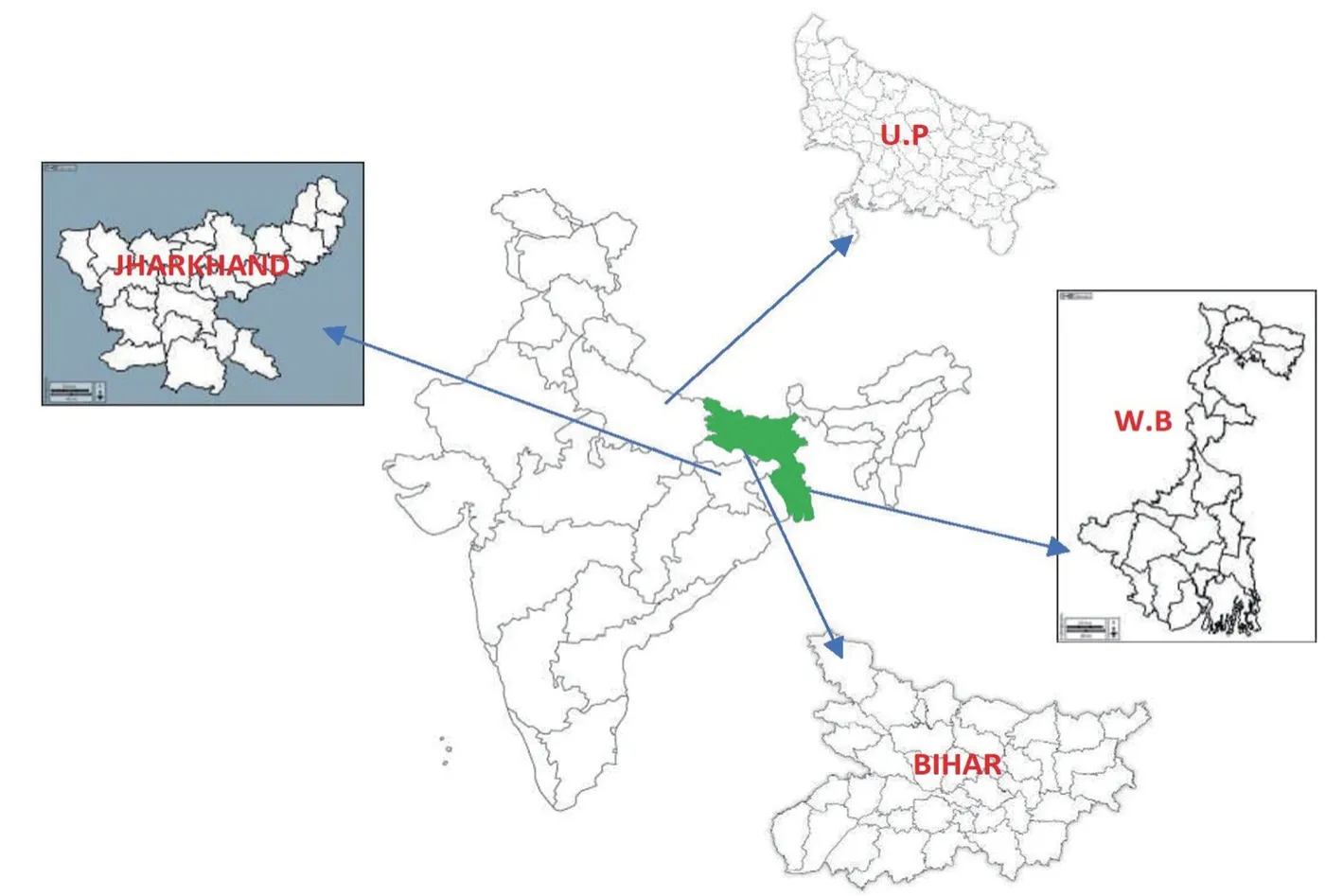
Figure 1.Epidemiological scenario of visceral leishmaniasis in India (NVBDCP 2023).
Visceral leishmaniasis is the second most lethal parasite disease after malaria estimated to affect 50 000 to 90 000 people worldwide each year[9].In 2020,ten countries (Brazil,China,Ethiopia,Eritrea,India,Kenya,Somalia,South Sudan,Sudan,and Yemen) accounted for more than 90% of all new cases reported by the WHO.VL cases are more prevented in India,East Africa,and Brazil.According to the Indian National Vector Borne Disease Control Program report,the eastern Indian states Bihar,Jharkhand,Uttar Pradesh,and West Bengal are endemic (Figure 1).There are 54 endemic districts and a few more areas with sporadic cases.A total of 4 states,with an estimated 165.4 million residents are at risk.The population residing mostly in rural areas belonging to low socioeconomic classes[10].
3.Pathogenesis of visceral leishmaniasis
The clinical outcome ofLeishmaniais influenced by the complex relationship between the parasite and host.Here the role of neutrophils,macrophages,and the duality role of TLR are highlighted.
The first interaction between neutrophils and parasites may alter subsequent innate and adaptive immune responses,which could affect the progression of the disease.Neutrophils,as the body’s first line of defense againstLeishmaniainfection,have a variety of pattern recognition receptors,including toll-like receptors (TLRs) and nucleotide-binding oligomerization domain-like receptors.When in contact with pathogen-associated molecular patterns on the surface of theLeishmaniaparasite,neutrophils trigger several microbicidal reactions,such as the production of granular proteins,a respiratory burst,nitric oxide (NO) and the formation of extracellular neutrophil traps[12].By secreting different chemokines and cytokines,they also actively participate in the control of T-cell responses.However,Leishmaniaparasites can get around these immune systems and successfully establish infection using either the ‘Trojan horse’ or‘Trojan rabbit’ models,depending on the infecting species and hostrelated parameters[13].
Leishmaniahas developed a variety of survival tactics during millions of years of co-evolution with its mammalian hosts,both to avoid killing neutrophils and to gain an advantage for spreading throughout the host’s body[14].Different species ofLeishmaniahave developed in particular ways to circumvent the effector defense systems of neutrophils,such as inhibiting the formation of reactive oxygen species (ROS) and phagolysosome growth.Instead of phagolysosomes,certain organisms can dwell intracellularly in nonlithic compartments with membranes that resemble the endoplasmic reticulum.
Neutrophils infected withLeishmaniarelease live parasites,which can ingest inflammatory monocytes,or undergo apoptosis and absorb DCs or macrophages.Chemokines MIP-1α and MIP-1β aid in macrophage recruitment[15,16].The interaction with macrophages depends on the neutrophil type,with macrophages detecting apoptotic host cells and foreign pathogens using scavenger receptors,among which the phosphoinositide serine (PS) receptor is the most common.Flippases are activated quickly by infected neutrophils to produce PS molecules,which are a sign of apoptotic cells.Since the cell isn’t dying but instead mimics the outer membrane of an apoptotic cell,this display is often referred to as apoptosis mimicry.This results in a toned-down macrophage response that is focused on clearing apoptotic cells,which prevents the production of microbicidal activities[17-19].The uptake of infected apoptotic cells causes macrophages to release transforming growth factor β (TGF-β),which creates an environment that is anti-inflammatory and encourages the proliferation ofL.major[20].Afonsoet al.observed similar outcomes withL.amazonensis,showing that necrotic neutrophils caused macrophages to removeL.amazonensisparasites in a TNF-α and neutrophil elastase (a serine protease that triggers the production of TNF-α)-dependent manner,but apoptotic neutrophils promoted TGF-β1 and PGE2-dependent parasite development in macrophages[21].Macrophages eliminate pathogens through NO production,but the parasite inactivates NFκB,preventing NO synthesized from L-arg,and activates arginase,promoting parasite proliferation (Figure 2C)[11,22-26].
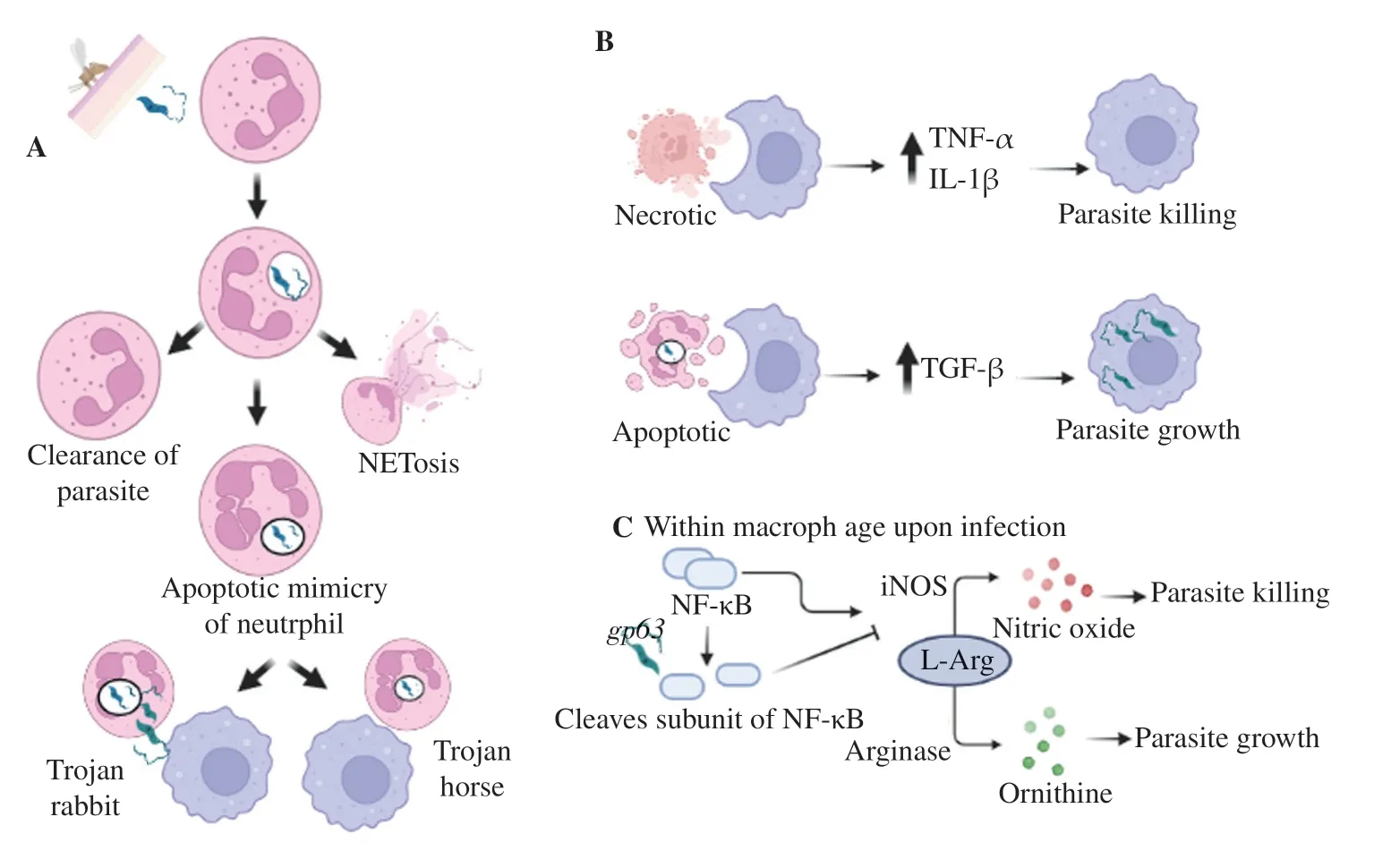
Figure 2.(A) The path taken by the Leishmania parasite through neutrophils and its temporary host is depicted schematically.Clearing the infection:Intracellular parasites may be killed by host neutrophils.Apoptotic mimicry: By exposing phosphatidylserine on the outer membrane neutrophils themselves look like apoptotic cells by which they are target macrophages for clearing apoptotic cells thus preventing the production of microbicidal activities.NETosis: Neutrophils actively degranulate to create neutrophil extracellular traps (NETs);this process is known as NETosis.NETs are designed to capture parasites,which emit a variety of antimicrobial enzymes and substances to eliminate the parasite from the body.(B) The anti-inflammatory cytokine TGF-β,which is secreted in large quantities by macrophages when they engage with apoptotic neutrophils,dampens the antiparasitic response to promote parasite development and multiplication.On the other hand,necrotic neutrophils encourage nearby macrophages to release strong proinflammatory cytokines,which promote improved parasite killing and infection resolution.(C) Strategies of Leishmania parasite to escape nitric oxide-mediated killing inside macrophages.
TLRs have multiple functions that make it difficult to distinguish between immune responses that are disease-promoting and hostprotective,or pro-and anti-leishmanial.TLRs can influence the T cell response,which ultimately determines the fate of the parasite,even though they are not directly responsible for the result of infection[27].
The TLRs can heterodimerize to broaden the range of antigens detected TLR-2,which may attach to either TLR-1 or TLR-6 in mice or TLR-10 in humans,is the most adaptable[28].Dichotomous immunological reactions toLeishmaniainfection are caused by toll-like receptor 2 (TLR-2) heterodimers.TLR-1-TLR-2 heterodimerization and TLR-2 homodimerization lead to an extracellular regulated kinase (ERK-1/2) phosphorylation and release interleukin (IL)-10 and transforming growth factor β (TGF-β) secretion promotes intracellular parasite survival[27];while TLR-2-TLR-6 heterodimerization causes the elimination of parasites through the production of IL-12 and tumor necrosis factor α (TNF-α) by activating the p38 mitogen-activated protein kinase pathway[27].
4.Present treatment regimen and its limitations
4.1.Monotherapy
Current therapeutic strategies to control leishmaniasis comprise several drug regimens with their limitations.Among those drugs,pentavalent is considered anti-leishmanial but its efficacy is limited in the Indian sub-continent region.The recently active drugs for leishmaniasis treatment with their doses,efficacy,advantages,and disadvantages are listed in Table 1.

Table 1.Medications currently used to treat visceral leishmaniasis.
Therapeutic regimens to control leishmaniasis comprise mainly five types of options at present: Pentavalent antimonials (SbV),amphotericin B,miltefosine,paromomycin,and pentamidine.Initially,antimonials were used as the primary treatment against leishmaniasis worldwide.However,unresponsiveness of Sbv was reported from Bihar,India (65% treatment failure),and Nepal (24%treatment failure)[29,30].Reports on SbV treatment of HIV-VL coinfection have revealed less therapeutic response with an increased mortality rate than HIV patients without VL[31].
Other reports demonstrated that SbV resistance is spreading all over the Indian subcontinent due to the expression of thiol-dependent metabolism,the presence of multi-drug resistance transporter,and reduced drug uptake due to less expression of aquaglycoporins in experimental models[32].Thereby,metabolic studies have identified variations in the amino acid pathway[33],which alters the genome plasticity inLeishmaniaparasites,confirming the idea of resistant phenotypes in the population.Because ergosterol is replaced by its precursor cholesta-5,7,24-trien-3-ol in the parasite’s cell membrane,the effectiveness of the treatment regimen is decreased,leading to the establishment of amphotericin B resistance.This resistance is also connected with gene amplification in extrachromosomal DNA[34].Although the main limiting factor is its high price on the market,lipid formulations of amphotericin B (AmBisome) are widely used for the treatment of leishmaniasis in India due to their increased efficacy.In addition,the ABC transporter’s (MDR1) expression level is a significant contributor to amphotericin B resistance in clinical isolates.
Miltefosine,which can only be taken orally,has shown signs of developing drug resistance.Miltefosine resistance is thought to be caused by mutations in LdROS-3 and LdMT,which significantly reduce the intracellular susceptibility to miltefosine in clinically separated phenotypes[35].
Apart from that,increased efflux is another factor responsible for miltefosine resistance.In the case of miltefosine responsiveness strain,ROS level is highly accumulated to kill the parasites,while in the case of miltefosine,unresponsiveness phenotypes tend to involve redox machinery and reduce ROS generation more efficiently.Consequently,resistantL.donovaniparasites are capable of coping with the redox mechanism to inhibit programmed cell death[36].Additionally,paromomycin involves protein synthesis and is responsible for the alteration in mitochondrial membrane potential.The resistance of paromomycin reduces its binding to the parasite’s surface and increases the expression of the ABC transporter protein[37].
The VL elimination campaign is in jeopardy due to the increased drug resistance;hence,research is needed to find better treatment options.Therefore,combination therapy might be a better alternative approach to combat leishmaniasis for its better efficacy.
4.2.Combination therapy
The components of the combination should ideally have complementary pharmacokinetic properties and/or diverse pharmacodynamic properties for activity,as well as function synergistically or at least additively.The rationale for this latter trait is based on an analogy with malaria treatment,where one medicine quickly reduces the biomass of parasites while the second,sloweracting drug will persist long enough to guarantee the death of any remaining parasites.In the case of malaria,the fast-acting component is an artemisinin-type drug that is administered once daily for three days.For leishmaniasis,the fast-acting component is likely to be liposomal amphotericin B,which is 91% and 96% effective at a single dose of 5 and 10 mg/kg,respectively[44].It should be active against allLeishmaniaspecies in all regions,with a minimum focus onL.donovaniin the Indian subcontinent and/or Africa.It should also be ideally effective in both immunocompetent and compromised individuals,with a minimum requirement of at least 95% clinical/parasitological efficacy in immunocompetent patients,and ideally safer than the current monotherapies (lower total exposure).
Some other factors like drug distribution,drug uptake,and release play a crucial role in treatment specifically when parasites attack the reticuloendothelial system.It has various advantages including reducing the dosage of drugs,chances of less toxic side effects,and duration of drugs,and providing a cost-effective option[45].In addition,combination therapy can improve the drug’s therapeutic life span.Several works are done in combination therapy,some of which are in a clinical trial for better treatment outcomes.Mostpharmacological combinations are used in the Indian subcontinent region and several locations in Africa,either as part of a single regimen or in combination[46].
4.3.Liposomal amphotericin B in combination therapy
In vitrostudy has shown that the use of allicin and amphotericin B in combination therapy againstL.donovaniandL.infantumdemonstrated a synergistic effect.The results of these studies demonstrated that allicin dramatically boosted the leishmanicidal efficiency of amphotericin B and decreased the amount of amphotericin B that was needed to completely eradicateLeishmaniaintra-macrophagic infection[47].Similarly,anin vitrostudy using the polyphenol chemical resveratrol,which is generated from black grapes,and the wine showed synergy with amphotericin B againstL.amazonensis[48].In Bihar state,India,a randomized phase Ⅲ clinical study using liposomal amphotericin B (L-AmB) and miltefosine treatment was carried out.In this trial,the cure rate was 98% after 10 days of treatment with miltefosine and 5 mg/kg of L-AmB,compared to a 91% cure rate among 45 patients after L-AmB treatment alone.This study was confirmed as a safe well-tolerated combinatorial treatment for leishmaniasis in India[5].Another trial thoroughly described the combination therapy with miltefosine and L-AmB.A short course of miltefosine at 2.5 mg/kg/day for 14 days and an Indian preparation of L-AmB at 7.5 mg/kg per dosage resulted in a 100% overall cure rate in 66 patients,which was a considerably higher cure rate than miltefosine (2.5 mg/kg/day for 28 days) monotherapy against VL[49].
As a result,it was determined that the combination of miltefosine(100 mg/kg for 28 days) and L-AmB (30 mg/kg) in Ethiopia resulted in an 88% cure rate at day 58 after therapy[50].The summary of L-AmpB medication combinations and cure rates are presented in Table 2.

Table 2.List of combination drugs with L-amphotericin B.
However,the intricate interactions between many parasite species,people,epidemiology,and medications indicate that there might not be a single cure that works for all endemic locations.As a result,scientists are continually doing investigations to find out the more effective combination of drugs against VL.
5.Alternatives in visceral leishmaniasis therapy
5.1.Immunomodulators against visceral leishmaniasis
In recent years,drug resistance has grown to be a significant hurdle for effective treatment of visceral leishmaniasis.Immunomodulators are crucial in the current environment to fight many diseases[51].In contrast to suppressing the host immune system during organ transplantation and the treatment of allergies,immunomodulators boost the immune response against infectious illnesses and malignancies[52-55].Some immunomodulators have been shown to have antileishmanial effects[56-60].Antileishmanial medications have frequently employed immunomodulators such as sodium antimony gluconate,arabinosylated lipoarabinomannan,and glycyrrhizic acid[60-62].
In a more recent study,Royet al.reported that the use of immunomodulators caused the down-regulation of PKCζ,the conversion of anti-inflammatory cytokines into pro-inflammatory cytokines,and the inhibition of plasma-membrane-calcium-ATPase in infected macrophages (PMCA4).Through the activation of PKCζ,plasma membrane-associated ceramide,which is known to be increased during leishmaniasis,caused the overexpression of PMCA4.It’s interesting to note that immunomodulators lowered ceramide production,which in turn decreased PKCζ activation and decreased PMCA expression in infected macrophages.Through the suppression of ceramide-mediated upregulation of PKCζ,their work clarified the effectiveness of sodium antimony gluconate,arabinosylated lipoarabinomannan,and glycyrrhizic acid in lowering the parasite burden in macrophages[63].
In this context,several plant-derived phytochemical compounds and their chemically synthesized derivatives could provide a new treatment approach.Eugenol,a plant-derived phytocompounds in essential oil,and its’ potential lead derivative,eugenol oleate,might be useful for a combinatorial alternative option to treat experimental VL.
5.2.The anti-visceral leishmaniasis activity of eugenol oleate
Our study has revealed that the eugenol derivative octadec-8-enoic acid 4-allyl-2-methoxy-phenyl ester,also known as eugenol oleate,is an immunomodulatory anti-leishmanial agent[64].Several eugenol compounds may have anti-leishmanial activity with fewer toxicities,according to research from our lab.These compounds offer new insights for treating VL[65].Eugenol oleate demonstrated superior potential againstL.donovaniamong these anti-leishmanial eugenol derivatives in various aspects.Eugenol oleate demonstrated anti-leishmanial action againstL.donovanipromastigotes and amastigotes,with EC50values of 20.13 M and 4.25 M,respectively.Besides,it was experimentally observed that eugenol oleate had a high therapeutic index of 82.24 against intracellular amastigotes which was a 10-13 folds increase over the standard drug amphotericin B and miltefosine.Furthermore,it was reported that eugenol oleate reduced arginase-1 activity,which is responsible for downregulating L-arginine availability for NO generation inside macrophages.Similarly,it was evidenced that eugenol oleate enhanced the level of Th-1 cytokines and reduced the expression of Th-2 cytokines.
Eugenol oleate’s effectiveness was also confirmed inin vivoresearch with BALB/c mice.L.donovani-infected mice were administered 10 mg/kg b.wt.and 25 mg/kg b.wt.,intravenously at five-day intervals for 28 days to test thein vivoefficacy of eugenol oleate.Infected mice treated with 10 mg/kg and 25 mg/kg of eugenol oleate showed a parasite burden clearance of 81% and 92% in the liver and 72% and 87% in the spleen.Additionally,fromin vivostudies,it was evidenced that eugenol oleate could enhance proinflammatory cytokines to kill parasites.
Likewise,it was also proved that eugenol derivatives have better efficacy through intravenous injection as well as oral treatment.We recently reported the eugenol oleate LD50and discovered>5 000 mg/kg b.wt.Additionally,it was discovered that after 3 to 5 days of post-treatment at 30 mg/kg b.wt orally,there was >84%parasite clearance in the liver and spleen.Eugenol oleate had been selected for further investigation based on its anti-leishmanial activity againstLeishmaniaspp.[66].
By increasing the expression of Th-1 cytokines by oral and intravenous routes of administration without causing hepatic and renal damage,eugenol oleate eliminates the parasite burden in infected BALB/c mice,according to earlier findings of thein vitroandin vivostudies.
By boosting the host immune response,the addition of immunomodulators to standard anti-leishmanial therapy can increase the effectiveness of the existing regimen[67].With lower EC50,higher therapeutic index,rapid disease resolution,immunomodulatory activity against intracellular amastigotes,and lesser toxicity,eugenol oleate presents a promising candidate for potential combination with traditional treatments forLeishmaniaparasites.
5.3.Combination therapy with eugenol oleate
In vitroandin vivoanti-leishmanial activity in combination with eugenol oleate and miltefosine was reported by Karet al.in 2021[68].The combined IC50for eugenol oleate and miltefosine againstL.donovanipromastigotes were 23.71 M for eugenol oleate and 7.46 M for miltefosine alone.From the combination study,xΣFIC was determined to be at 1.13,indicating that these two drugs had an additive effect onL.donovanipromastigotes.The antiamastigote activity of miltefosine (0-10 M) and eugenol oleate(0-10 M) infected macrophages was then assessed.Additionally,anin vitroinvestigation found that amastigotes were resistant to additive interactions with xΣFIC of 0.68.Therefore,81.69% of the parasites were killed by the chosen doses of eugenol oleate (5 M) in combination with 1.25 M of miltefosine in infected macrophages[68].A study using isobolograms revealed that the x∑FIC value was 1.015,indicating an additive interaction between the two medicines andL.donovanipromastigotes.Eugenol oleate (0-10 M) and amphotericin B (0-2.5 M) were also tested for their effectiveness againstL.donovaniamastigotes in BLAB/c derived infected macrophages[69].
Moreover,anin vivoexperiment using an oral-oral combination showed that miltefosine (5 mg/kg b.wt) and eugenol oleate (15 mg/kg b.wt) together caused 88.76% and 80.6%,respectively,inductions in the liver and spleen of infected BALB/c mice.This combination,when taken orally,caused splenocytes to release IL-2 and other proinflammatory cytokines and stimulated moderate T-cell proliferation.The aforementioned combination therapy included eugenol oleate,an anti-leishmanial immunomodulator,and miltefosine,an antileishmanial having greater activity againstL.donovani.
5.4.Liposomal treatment in visceral leishmaniasis leads to miraculous changes
In 1964,Bangham and his colleague Thome published the first description of liposomes[70].Due to its extensive usage as a drug carrier for the administration of drugs that are selective and targeted,this has given rise to a significant field of study[71,72].Liposomes has advantages in various aspects,including: 1) The ability to transport both lipid and water-soluble medicines;2) Non-ionic in composition;3) Fully biodegradable,non-toxic,and non-immunogenic;4)Appropriate for the delivery of drugs that are hydrophobic,amphipathic,and hydrophilic;5) The ability to keep the medicine in its capsule away from the surroundings;6) Increases stability and decreases toxicity through encapsulation;7) The ability to boost the drug’s ability to treat cancer;8) Drugs that degrade naturally can be protected against oxidation;9) Lessen the number of harmful medications that reach delicate tissues;10) Enhance the stability ofproteins;11) Control the hydration;12) Offer a steady release;13)Site-specific drug delivery or targeted drug delivery;and 14) Can be given by a variety of routes[73,74].
Blacket al.were pioneers in using liposomal drug for treating VL.Soon after Newet al.selectively delivered the pentavalent antimony to the liver and spleen macrophages infected with VL.When tested on golden hamsters infected withL.donovani,Alvinget al.found that liposome-encapsulated antimonial pharmaceuticals (meglumine antimoniate and sodium stibogluconate) were 700 times more potent as an anti-leishmanial agent than the comparable antimonial drugs alone.When using liposome-entrapped antileishmanial drugs against visceral leishmaniasis,it shouted as a better weapon than free-alone drug administration.It will be like a double-edged sword against the ghoulishLeishmaniaparasite.Several authors[75-82]confirmed that the treatment was 700 times more effective when treated with lyophilized tiny unilamellar vesicles made of distearoylglycerol-phosphocholine,cholesterol,and dodecyl phosphocholine(5: 4: 1 mol%),reconstituted in phosphate buffer,pH 7.2,as opposed to non-encapsulated antimonials in an animal model of visceral leishmaniasis.When treated with liposomal ampB at a dose of 3.3 mg/kg to a naturally infected dog withL.infantumwithin received 3-5 administrations of this formulation showed rapid clinical improvement from deterioration of splenomegaly and lymph adenomegaly.The treatment option with an antimonial group such as sodium stibogluconate or meglumine antimoniate liposomal entrapped showed better efficacy[83-88].From the study of Schettiniet al.,it can be conferred that the size of the liposome is the most important factor and it revealed throughout their study when drugs were passively targeted to the bone marrow of dogs with VL infection,a liposomal formulation of meglumine antimoniate of smaller size (400 nm) at a dose of 4.2 mg/kg (body weight) showed three-fold enhanced bone marrow antimony level in comparison to the drug encapsulated in large liposomes (1 200 nm)[85].
Momeniet al.reported that the surface charge is significant in the liposome preparation process,with negatively charged lipids(zeta potential=-60 mv) having smaller size liposomes and a higher percentage of encapsulated efficiency when this group prepares three antileishmanial liposomal drugs: glucantime,miltefosine,and paromomycin using different lipids and modified emulsion/freeze dry[89].The effectiveness of second-line treatments such as miltefosine[90] and amphotericin B was evaluated following the resistance linked to antimonials[91-94].When compared to unencapsulated miltefosine,liposomal miltefosine has several advantages.A study by Bodheet al.revealed that meglumine antimoniate liposomal amphotericin B was 350-750 times more active and 2-5 times more effective at treating experimental VL than free amphotericin B.According to its distinct liposome and sterol binding thermodynamics composition,liposomal-entrapped ampB in human VL demonstrates good efficacy,as well as certain macrophage targeting and delaying its clearance from the site of infection[95-100].In this regard,Ghoshet al.showed that membrane cholesterol contributes to protection againstL.donovaniinfection.In this study,they removed membrane cholesterol from macrophages and disrupted lipid rafts,which prevented them from stimulating T cells[101].After the aforementioned flaws are corrected,liposomal administration of membrane cholesterol protects hamsters fromL.donovaniinfection.Asadet al.found that a novel ergesterol-rich liposomal ampB (KALSOMETM10) significantly reduced the parasite burden in infected BALB/c mice,leading to almost full elimination of parasites from the liver and spleen[102].Intriguingly,the levels of IFNγ and IL-12,two cytokines essential for disease control,are markedly elevated while the secretion of the diseasepromoting cytokines IL-10 and TGF-β is inhibited.It is also apparent that there are no hepato-or nephrotoxic side effects after treatment.Meglumine antimoniate in liposomes containing phosphatidylserine (PS) was found by Borboremaet al.in 2018 to promote sustained levels of the drug for a longer amount of time than the free drug[103].The significance of PS-liposomes as prospective medication delivery vehicles for VL is emphasized work.According to Peineet al.,liposomal resiquimod therapy dramatically reduced the parasite load in the liver,spleen,and bone marrow[104].In an antigen recall experiment,resiquimod therapy also boosted interferon-γ and interleukin-10 production.In vitro,culture tests and research with histology have demonstrated that resiquimod is not harmful.For the first time,Romanelliet al.assessed the antidepressant sertraline’sin vivoeffectiveness in a VLexperimental mouse model and investigated its immunomodulatory effect following treatment[105].Additionally,a delivery experiment was created to show how well LP-SERT could target the liver and spleen.Additionally,in vitrotests were carried out to assess the host cell uptake,mammalian cytotoxicity,andin vitroeffectiveness.In comparison to the untreated group,the results showed that LP-SERT treatment was effective in lowering the liver parasite load by 72% at 0.3 mg/kg (P<0.05) and by 89% at 1 mg/kg (P<0.05).Mukherjeeet al.examined the effectiveness of an imipramine-entrapped liposome formulation in mouse and hamster leishmaniasis modelsin vitroandin vivoin 2020[106].They demonstrated that imipramine liposomal formulation is a more effective antileishmanial candidate than imipramine monohydrate.In this new formulation,they noticed a sharp reduction in imipramine dose that eliminated 100% of the organ parasite load.Lists of anti-leishmanial liposomal medications for the treatment of leishmaniasis are presented in Table 3 along with the percentages of cure rate.
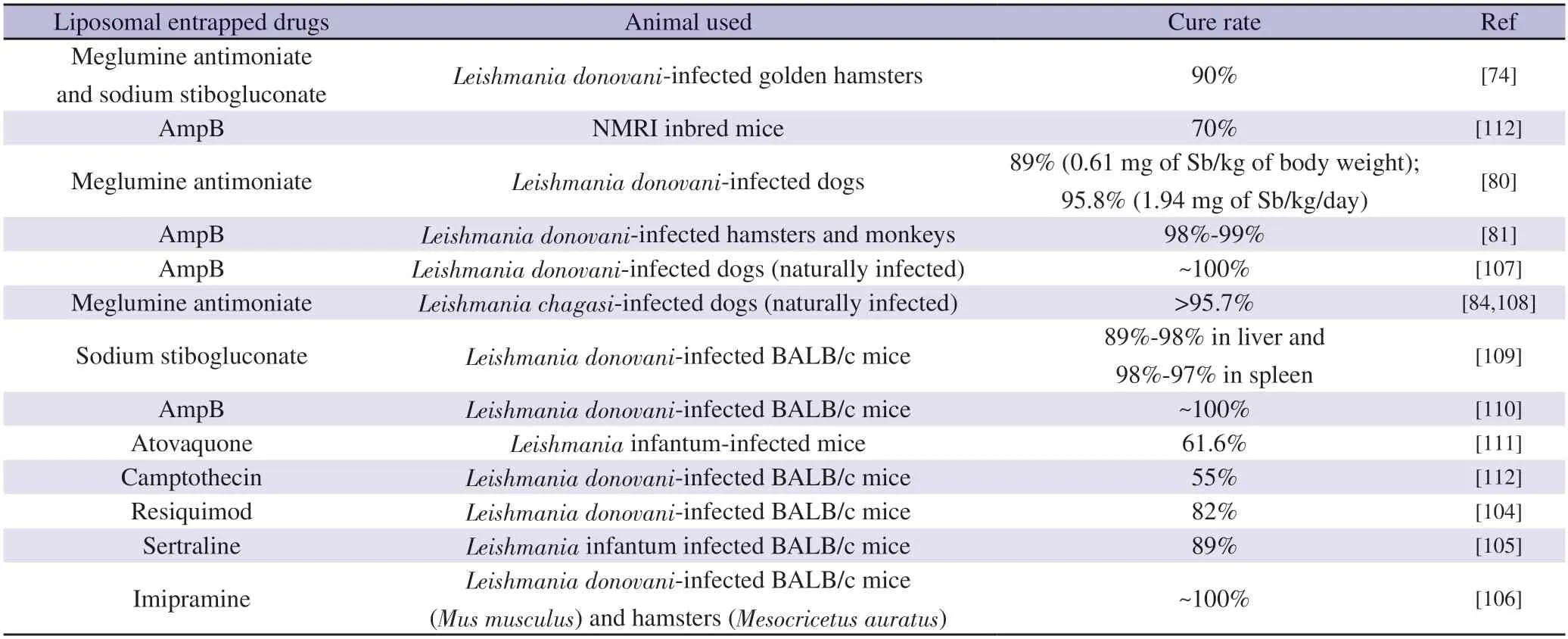
Table 3.Liposomal encapsulated drugs against visceral leishmaniasis.
5.5.Factors that affect liposomal drug encapsulations
The physicochemical properties of liposomes strongly influence drug encapsulation efficiency and they commonly target macrophages making liposomes a potential candidate for the treatment of visceral leishmaniasis by serving as effective drug delivery vehicles.
Smaller liposomes have a longer circulation time and significantly greater penetration into tissues like the liver and spleen,where resideLeishmaniaparasite.Treatment ofL.infantum-infected dogs with a 400 nm meglumine antimoniate-liposome delivered antimony to the bone marrow at a level that was three times higher than that of the 1 200 nm liposome,indicating that it may more efficiently remove parasites from this tissue[84].More effective than larger liposomes at reducing the number ofLeishmaniaparasites in mouse bone marrow were those with a diameter of 100 nm[113].
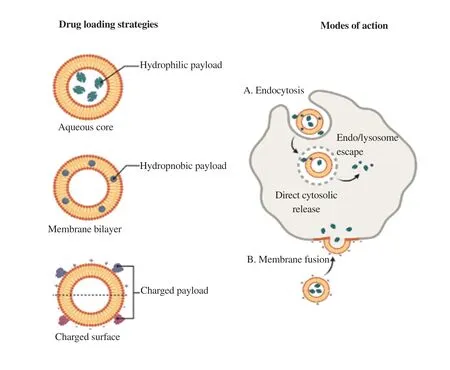
Figure 4.Mode of action of liposomal drug delivery.
The effectiveness of medication encapsulation and the interaction of liposomes with target cells are both significantly influenced by their surface charge.When the vesicles contained a negatively charged phospholipid like phosphatidylserine,the meglumine antimoniate was more effectively encapsulated[102].
The ability of liposomes to attach to and be phagocytosed by macrophages is considerably improved by the addition of phosphatidylserine or phosphatidylglycerol[114].
5.6.Targeting for macrophages
PS-based liposomes delivered antimony to intracellularL.chagasiamastigotes by binding to scavenger receptors (SR) in macrophages.It has been demonstrated that macrophages infected withLeishmaniaupregulate the SRs CD36,SRB-1,and MARCO.SRs could therefore be a suitable target for PS liposomes (Figure 3)[115].Due to changes in phagocytic behavior during infection,PS MA-liposome was preferentially picked up by infected macrophages approaching the amastigotes as opposed to the uninfected[84].
5.7.Mechanism of action of liposomes
An area of aqueous solution enclosed in a hydrophobic membrane makes up a liposome.Hydrophobic chemicals can be easily dissolved.Liposomes transport both hydrophilic and hydrophobic compounds into the lipid membranes.The drug's physiochemical properties and lipid makeup will determine its location and spread.The lipid bilayers combine with other bilayers of the cell (cell membrane) to release the liposomal content,which then transports the required drug molecules to the site of action (Figure 4).
The following steps are involved in medication delivery by liposomes[116]:
Ⅰ.Adsorption: When liposomes adhere to cell membranes,they come into contact with the membrane.
Ⅱ.Endocytosis: Adsorption of liposomes on the cell surface membrane followed by engulfment and internalization into the liposomes.
Ⅲ.Fusion: Direct delivery of liposomal contents into the cytoplasm is the achieved by fusion of the lipid bilayers of liposomes with the lipoidal cell membrane through lateral diffusion and lipid mixing.
Ⅳ.Lipid exchange: Since the phospholipids in cell membranes and the liposomal lipid membrane are similar,lipid transfer proteins in the cell membrane have an easy time identifying liposomes and causing lipid exchange.
6.Limitations
In this review article,we presumed that liposomal drug delivery might play a pivotal role in the treatment option against VL in near future.Therefore,we cited here the efficacy of liposomal entrapped conventional drugs,but we could not compare the efficacy of liposomal formulation with combination therapy.The use of immunomodulators is the most attractive therapeutic approach in the field of infectious diseases now a days,but here we cited the limited work on it as well as in their liposomal formulation.Not even,we could not discuss the suitability of dual drug-loaded liposomal formulation against particularly VL due to lack of proper references.With the stint,resistant strain uprising being the major issue in the treatment of VL,this review paper enlightened the prospect of DDL as a promising therapeutical approach.
7.Conclusions and perspectives
In prophylaxis application of liposomes is enormously appreciated and its use increases the efficacy of the drug by promoting tissue absorption and lowering its side effects by providing modifications or designing liposomes for the target site.Likewise,liposomal encapsulated single anti-leishmanial drug (existing or new) if effective then promising and ensuring the simultaneous release of combination drugs together at the site of infection through liposome may be a milestone in the treatment of VL.There are so many investigations that the administration of two medications via liposomes,or "dual drug liposome" formulation,has proven to be an effective weapon against various diseases like cancer,and HIV as far as reported,but not a single report is available against VL.
Conflict of interest statement
The authors declare that they have no known competing financial interests or personal relationships that could have appeared to influence the work reported in this paper.
Acknowledgments
The authors wish to share sincere gratitude to the Honorable Director of Midnapore City College,MORAINE Human Resource Development Organization,Midnapore.SKM gratefully acknowledges the support of Indian Council of Medical Research(ICMR),New Delhi,India (File No: 6/9-7(308)/2023-ECD-II).RH acknowledges the SVMCM fellowship,West Bengal.
Funding
It was supported by the Indian Council of Medical Research,New Delhi,India with No.6/9-7(308)/2023-ECD-Ⅱ.
Authors’ contributions
RH: validation,formal analysis,writing-original draft &revision;AK: writing-review &editing;SKM: conceptualization,formal analysis,resources,writing -original draft &revision,visualization,supervision,project administration,funding acquisition.
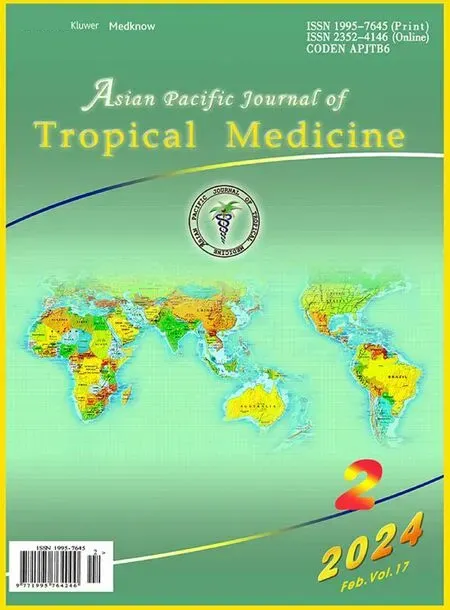 Asian Pacific Journal of Tropical Medicine2024年2期
Asian Pacific Journal of Tropical Medicine2024年2期
- Asian Pacific Journal of Tropical Medicine的其它文章
- Cardiovascular health awareness,risk perception,behavioural intention and INTERHEART risk stratification among middle-aged adults in Malaysia
- Prevalence and intensity of urinary schistosomiasis and soil-transmitted helminths among women of reproductive age in Mwaluphamba,Kwale
- Genetic diversity of the S-type small subunit ribosomal RNA gene of Plasmodium knowlesi isolates from Sabah,Malaysian Borneo and Peninsular Malaysia
- Bilateral adrenal histoplasmosis in a Malaysian tertiary hospital: Report of four cases
